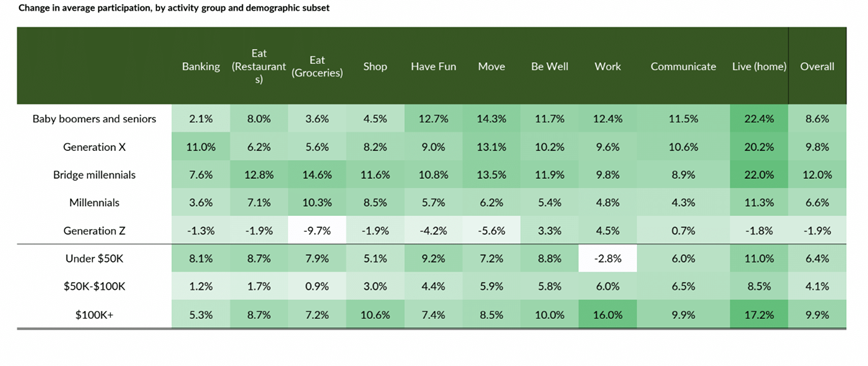The Great Remote Workforce Divide Gets Wider

This next installment of PYMNTS’ mini-series on consumer behaviors popularized during the pandemic demonstrates that workers may be in no rush to return to the office. The rate of employees engaging in remote work has continued to rise, with the growing shares illustrated in proprietary research carried out in preparation for PYMNTS’ May “ConnectedEconomy™ Monthly Report.”

More than three years after the pandemic began (and months since it was declared in the U.S. to be an emergency no longer), participation in work is still experiencing 9% year-over-year growth via gig platforms or logging into work platforms while not located within a traditional office setting. The growth suggests that this behavior may be here to stay, and our research also details the demographically lopsided nature of this increased participation.
 Our Work pillar encompasses digital engagement in both remote and platform work outside of traditional office settings, and the generation with the greatest change in average participation is baby boomers and seniors, who have exhibited a 12% improvement in our metrics. The digital engagement of millennials and members of Gen Z, has comparatively plateaued, not reaching a 5% positive change in average participation.
Our Work pillar encompasses digital engagement in both remote and platform work outside of traditional office settings, and the generation with the greatest change in average participation is baby boomers and seniors, who have exhibited a 12% improvement in our metrics. The digital engagement of millennials and members of Gen Z, has comparatively plateaued, not reaching a 5% positive change in average participation.
Consumers making over $100,000 per year were much more likely to exhibit more engagement with work outside traditional office settings, leading all brackets with 16% of positive change in average participation. Those numbers fall sharply to 6% for consumers making $50,000 to $100,000 annually and negative growth for those making under $50,000 annually. This may be partly due to higher-income employment often categorized as white-collar or other types of office work that may be done from home. This arrangement may not be possible for traditionally blue-collar jobs such as in retail or trade that generally require workers to perform their duties in person.
The income divide regarding digital engagement has been a long-running point of interest at PYMNTS, which found that middle- and- higher-income workers consistently worked outside traditional employment settings at rates consistently higher than lower-income workers.
While loathed by the commercial real estate sector and major commuter cities such as New York, these consumers spend more at locations closer to their workspace and digital platforms. The arrangement has also brought the added benefit of bridging some gaps in services consumers may need but cannot necessarily afford through the traditional in-office model. Pierre Proner, co-founder and CEO at U.K. tech firm Lawhive, details how high prices and lack of access to legal representation often prevent consumers and small businesses from seeking aid or upholding their rights.” A lot of the solicitors and lawyers that operate through Lawhive [have] left larger firms and want to practice on their own and have the freedom and flexibility in the way that they operate… Clients are charged a third of the amount that they would ordinarily have to pay in order to justify the time that the lawyer is taking. For us, that has been a radical realization and quite game-changing on the consumer pricing-access side.”
Remote work, once a pandemic stopgap, has since taken on a model of its own, though clearly not intended for every business. The shift in adoption by consumers and companies alike may demonstrate that, like subjects of other installments in this mini-series, this alternative to traditional work settings may become traditional.

